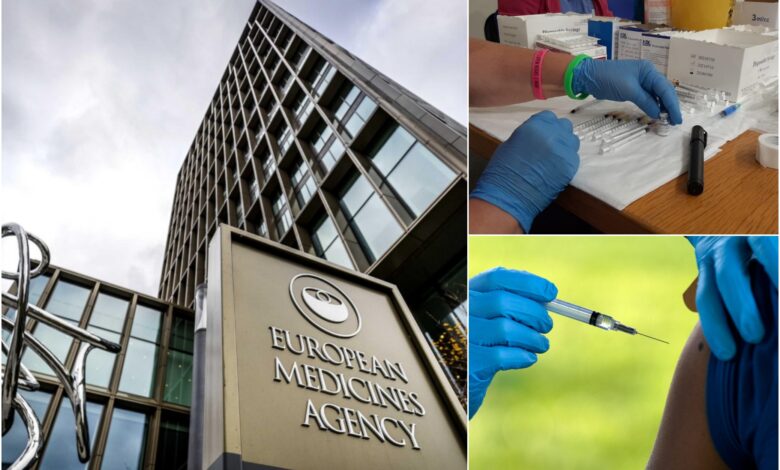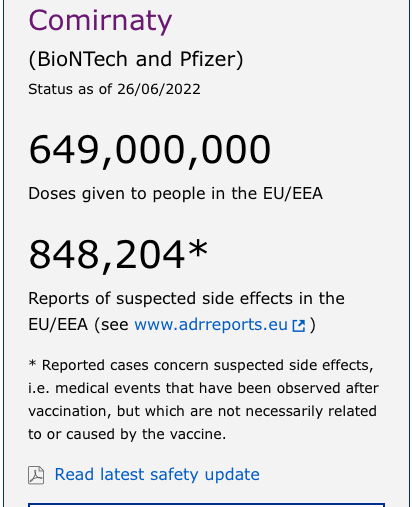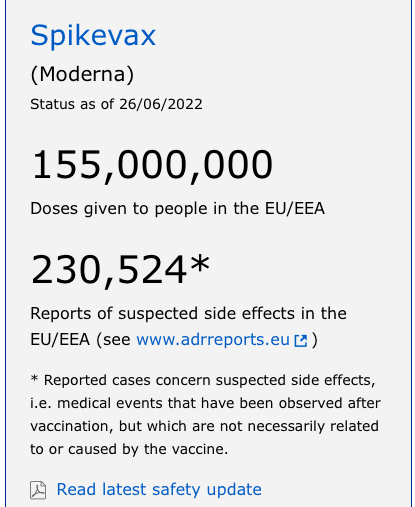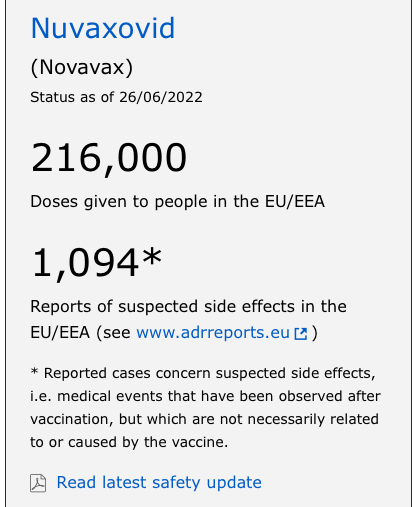
The European Medicines Agency (EMA) closely monitors the safety of COVID-19 vaccines authorized in the European Union (EU). This helps detect any rare side effects that may  emerge once many millions of people are vaccinated.
emerge once many millions of people are vaccinated.
- More than 892 million doses of vaccines were administered to people in the EU and the European Economic Area (EEA), as of the end of June 2022.
- Licensed COVID-19 vaccines are safe and effective. They have been evaluated in tens of thousands of participants in clinical trials and have met EMA's scientific standards for safety, efficacy and quality.
- The safety of COVID-19 vaccines is continuously monitored and evaluated.
- Monthly Security Updates provide an overview of your regular security assessment PRAC.
- The vast majority of known side effects from COVID-19 vaccines are mild and short-lived.
- Serious security problems are extremely rare.
The most recent safety information for each vaccine can be found in the Monthly Vaccine Safety Update, available via the links below.
The figures below provide the overall number of suspected side effects reported by individuals and healthcare professionals after using a COVID-19 vaccine in the EU and EEA.
The reported cases concern suspected side effects, i.e. medical events that have been observed after vaccination, but which are not necessarily related to or caused by the vaccine. The problem may still have occurred, for example, due to an unrelated health issue.
The nature of spontaneous reporting also means that some people may not have reported their side effects, particularly if they were mild.
For more information on these reports, see:
- European suspected adverse drug reactions database (www.adrreports.eu)
- Important information on how to interpret the data
 EMA will publish safety data for the COVID-19 vaccine Valneva, authorized to gi
EMA will publish safety data for the COVID-19 vaccine Valneva, authorized to gi June 2022, as soon as these become available.
June 2022, as soon as these become available.
As of May 2022, EMA uses a different method to calculate figures for doses of COVID-19 administered in the European Union/European Economic Area. Data from the June 2022 security updates should therefore not be compared with data published in previous months.
How EMA monitors vaccine safety
The EU safety monitoring plan for COVID-19 vaccines requires EMA to monitor suspected side effects reported by individuals and healthcare professionals in the EU.
 An EU database called EudraVigilance contains these reports. There European database on suspected adverse drug reactions provides public access to this data in various ways, taking into account EU data protection law.
An EU database called EudraVigilance contains these reports. There European database on suspected adverse drug reactions provides public access to this data in various ways, taking into account EU data protection law.
The PRAC of the EMA and the competent national authorities monitor constantly EudraVigilance to identify any new security issues that require investigation. These are known as safety signs.
When assessing a safety signal, the PRAC looks for any unusual or unexpected patterns, such as a medical event occurring in vaccinated people at a higher rate than in the general population.
They look at other sources of evidence, such as clinical studies, epidemiology and pharmacoepidemiology studies, medical literature and information from regulatory authorities outside the EU.
The PRAC then conducts a thorough assessment of all the combined safety data before concluding on how the signal affects the safety of the vaccine and its benefit-risk balance.
If necessary, the EMA may decide to update the information on the vaccine product to provide the right advice to healthcare professionals and patients, request the manufacturer to conduct further studies or limit the use of the vaccine.
Patients and healthcare professionals should report any suspected side effects after receiving a COVID-19 vaccine to their national competent authority. For information on how to do this, see:








